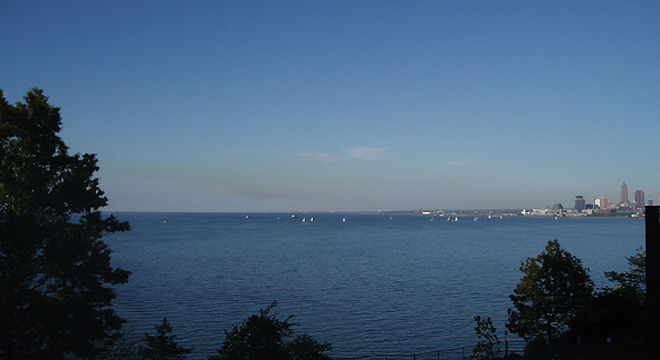Once an engine of American industry, could the city of Cleveland soon become a centerpiece of the country’s energy future?
One company is hoping to turn the city, or rather, the waters of Lake Erie off Cleveland’s shore, into the site of the nation’s first freshwater wind farm. And it’s pursuing a lucrative government grant in order to get the project going.
The company, the Lake Erie Energy Development Corporation, or LEEDCo., actually first announced its ambitious plan to develop the “Icebreaker” wind farm back in 2010, proposing to build a 20 megawatt total installation composed of 5 turbines made by General Electric, each turbine capable of producing 4 megawatts of energy.
The company was founded in 2009 as a private, nonprofit regional corporation, with the City of Cleveland as one of its creators.
But its initial “Icebreaker” project ran into trouble when local utilities balked at the costs of the project. Undaunted, LeedCo. proposed an alternate plan in May that would involve installing lighter turbines with lower energy output: anywhere from 5 to 9 individual turbines each producing 3 megawatts, enough to power around 8,900 homes.
German electronics company Siemens confirmed in June to ReCharge News that it was in talks to adapt onshore wind turbines to the task, but the publication reported that the deal could be dependent on LEEDCo. winning a total of $50.6 million in grants from the U.S. Energy Department to fund the project.
“LEEDCo. is not solely crutching on the DOE funding, but the opportunity is important,” LEEDCo. spokesman Donny Davis wrote to TPM in an emailed statement. “The team is continuing to make advances and adjustments to produce at project for the lowest cost possible.”
The Department of Energy announced in March the money would be made available only to select applicants as part of a competitive funding opportunity announcement totaling $180 million over six years, to be divided up into six different chunks of varying amounts.
The first awards, for $4 million each, are expected to be announced by the end of August to five companies (totaling $20 million) that can demonstrate they have the plans and all the components necessary to begin construction by the end of 2017. If LEEDCo. can secure that first round, it is on track to earn another $46.6 million over the next five years.
In total, Davis estimates that the project will cost $120 million to install. The remaining nearly $70 million he says is expected to come from “private sector equity and debt, financed by the revenues from electricity sales, plus tax-credits.”
Neither the Department of Energy nor LEEDCo. was able to tell TPM in time for publication who else was competing for the initial funds. Applications were due May 31, giving the potential applicants a tight window to get their plans together in time.
Still, LeedCo. is confident it has a sound application and that the waters of Lake Erie off Cleveland have the right ingredients to make it the most attractive spot for America’s first freshwater wind farm.
To begin with, Erie is the shallowest of the Great Lakes, with a depth of just around 60 feet near Cleveland, making installing such turbines easier and cheaper.
The wind in the region is “stronger and more consistent” than anywhere onshore in the state, too according to LEEDCo.’s Davis.
“LEEDCo is positive about its application and award effort submitted,” Davis told TPM. “Given Icebreaker is the most advanced project in the Great Lakes, we hope the DOE recognizes the opportunity this project could unlock for the entire region in terms of getting a first project done, subsequent innovation, and ultimately demonstrate the ability to lower costs.”
Lowering costs is key: The whole reason the government is willing to fund these efforts in the first place is part of the Obama Administration’s National Offshore Wind Strategy, a document released in February outlining the fact that there an estimated 4,000 gigawatts of “gross potential” of wind energy that is “relatively close” to key metropolitan, and thus, power-hungry areas. But the costs of installing and keeping up such windfarms are currently too high to make them really competitive, so the Energy Department is seeking to fund projects that can demonstrate speed and efficiency, and lower the cost of energy to $0.10 per-kilowatt-hour. As ReCharge points out, in Ohio, power from conventional sources costs about $0.06 per-kilowatt-hour, and onshore wind about $0.08 to $0.10.
Still, the entire promise of the “Icebreaker” wind project is predicted on Congress continuing to earmark funds for the broader Department of Energy offshore wind farm program, a tricky proposition.
“We know the first leg of the program is funded, but do not have the entire scope of vote dates and other earmarks spelled out clearly for us,” Davis admitted to TPM.
One thing’s for certain, residents of the state seem to be in support of the idea of such projects: A recent poll found that 8 in 10 Ohio residents agreed that alternative energies were important to the state’s economy going forward.






